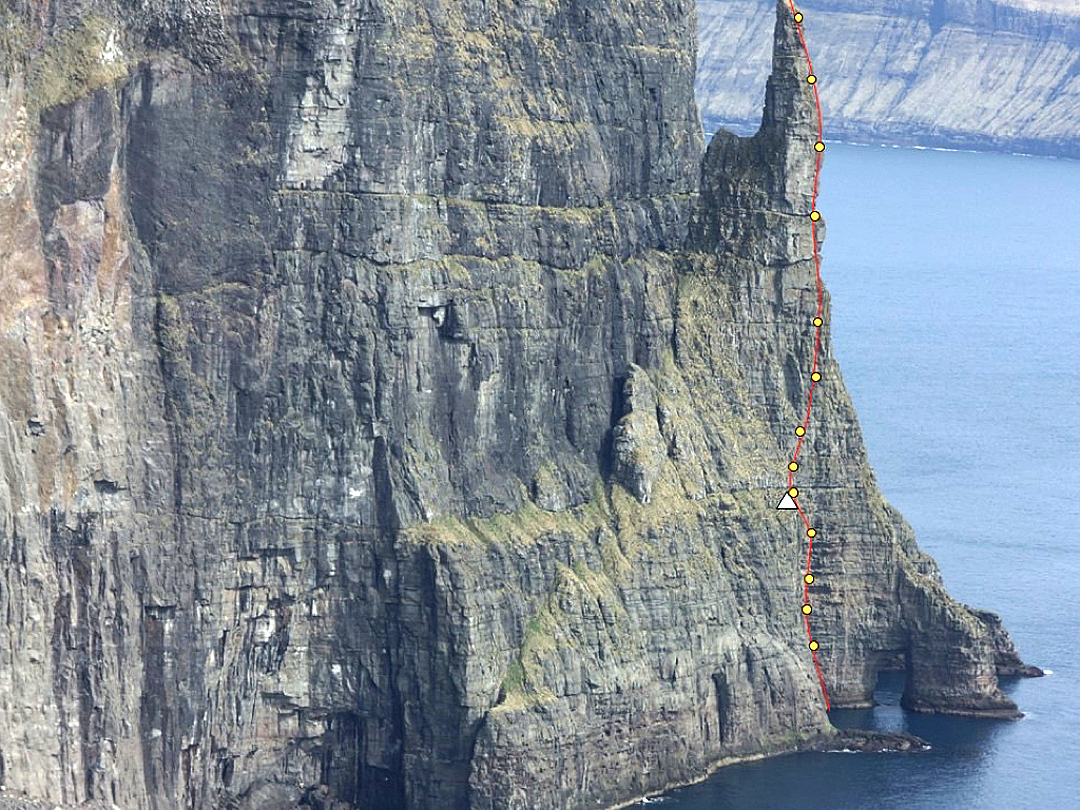Trøllkonufingur: Huffin & Puffin
Faroe Islands

 Jack Grinsted, Dave McKinney, and I, from New Zealand, established a new route, Huffin & Puffin (12 pitches, 7a A3), on the iconic Trøllkonufingur, a huge pillar along the coast of Vágar, one of the 18 Faroe Islands. The pillar previously had been climbed at least twice by Faroe islanders, via ramps on the left side leading to the notch behind the spire. We climbed directly up the 313m seaward face from the yacht Ljómer. After a first attempt during which we established two pitches before retreating in bad weather, the final ascent took five days, using a portaledge. We reached the top at 12:12 a.m. on July 31.
Jack Grinsted, Dave McKinney, and I, from New Zealand, established a new route, Huffin & Puffin (12 pitches, 7a A3), on the iconic Trøllkonufingur, a huge pillar along the coast of Vágar, one of the 18 Faroe Islands. The pillar previously had been climbed at least twice by Faroe islanders, via ramps on the left side leading to the notch behind the spire. We climbed directly up the 313m seaward face from the yacht Ljómer. After a first attempt during which we established two pitches before retreating in bad weather, the final ascent took five days, using a portaledge. We reached the top at 12:12 a.m. on July 31.
We aimed for as clean an ascent as possible, using trad gear where the rock allowed and placing all bolts on lead. Starting directly out of the ocean meant an exciting boat-to-rock transfer and made for a committing adventure. Another challenge was the resident population of fulmar seabirds, which roost on the ledges of the sea cliffs and defend their small territories with putrid vomit.
For our final ascent we hauled three days of food and water, but after three long and demanding days we were still two pitches from the summit. At this point we didn’t have enough rope to return to our emergency food stash at the base of the spire without pulling down our fixed lines. We opted for a final push to the top the next day. This was a 26-hour camp-to-camp effort, as we were forced to bivouac just below the summit before descending to pack up our camp, removing all gear and waste.
In addition to climbing Trøllkonufingur, we established a handful of new routes at Norðadalur, a new and exceptional crag on the west coast of Streymoy island, near Torshavn, the capital of the Faroes. Norðadalur is an impressive series of 15 to 50m columnar basalt cliffs with phenomenal scope for further development. With rock climbing really in its infancy on the Faroe Islands, there was great need for some beginner routes. We identified an area of rock that was slightly off vertical, which we named Kiwi Crag, and established ground-up ascents of eight new routes—six trad and two bolted. (Download a photo topo.)
We got immense support from the local Faroese community, particularly Absalon Eysturoy and his family, who were instrumental in making this ascent possible. Eysturoy is a Faroese climber living in Copenhagen and was the instigator of the project; he also climbed with us on the first attempt on Trøllkonufingur. Our trip was largely funded by the Sport NZ Hillary Expedition Fund.
– Jason Blair, New Zealand








